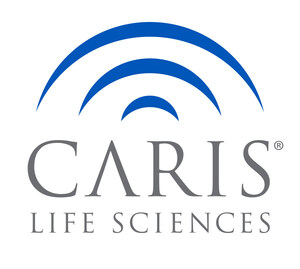Caris Molecular Intelligence Tumor Profiling Identifies Potential Responders to Anticancer Therapy Across a Range of Tumor Types
IRVING, Texas, Sept. 28, 2015 /PRNewswire/ -- Caris Life Sciences®, a leading biotechnology company focused on fulfilling the promise of precision medicine, today announced the presentation of three separate datasets in which Caris Molecular Intelligence®, the company's panomic comprehensive tumor profiling service, facilitated the identification of potential responders to anticancer therapy across a range of tumor types. Results from the three studies, presented during a poster session at the 2015 European Cancer Congress (ECC2015) in Vienna, Austria, shed light on potential treatment strategies for patients whose tumors harbor BRCA1 and BRCA2 mutations, BRAF mutations, and aberrantly expressed ALK oncogenes, respectively.
"As more is learned about the biomarker expression patterns of various tumor types, it is becoming increasingly important to match that knowledge with clinical evidence of response to specific classes of anticancer agents," said Sandeep K. Reddy, M.D., Chief Medical Officer at Caris Life Sciences. "The data presented at ECC2015 further demonstrates how tumor profiling is helping practicing oncologists devise personalized treatment plans based on the molecular characteristics of individual patients' tumors."
BRCA1 and BRCA2 Mutations in Epithelial Ovarian Tumors (abstract #2771)
In one ECC2015 poster presentation, a team of researchers led by Thomas Herzog, M.D., of the University of Cincinnati College of Medicine used Caris Molecular Intelligence to analyze 1,691 epithelial ovarian cancer (EOC) tumor samples to identify BRCA1 and BRCA2 mutations in various histological subtypes of EOC, and to identify molecular differences in EOCs with or without BRCA1 or BRCA2 mutations. Using Caris' multiplatform profiling techniques, such as gene sequencing (Next-Generation Sequencing [NGS], Sanger and Pyro Sequencing), protein expression analysis (Immunohistochemistry [IHC]), and gene copy number and translocation analysis (Chromogenic or Fluorescence in situ hybridization [CISH or FISH]), investigators observed deleterious and mutually exclusive BRCA1 and BRCA2 mutations in 9% and 5% of EOC tumors, respectively.
Investigation into various histological subtypes of EOC tumors shows that while the most common histology carries the highest mutation rates of both BRCA1/2, 11% and 6%, respectively; the much rarer subtypes including carcinosarcoma, clear cell and endometrioid subtypes also showed BRCA1/2 mutations at frequencies ranging from 2-6%. In addition to well-characterized deleterious BRCA1/2 mutations, presumed pathogenic variants and variants of unknown significance of BRCA1/2 mutations were observed in 4 and 8% of EOC tumors, respectively, the functional effects and therapeutic impact of which warrant further investigation.
The study also included a comprehensive comparison of EOC tumors with or without deleterious BRCA1 or BRCA2 mutations. While TP53 mutations likely co-occur with BRCA1 or BRCA2 mutations, BRCA1/2 wild-type EOC tumors more frequently carry KRAS, PIK3CA and CTNNB1 mutations or present cMET overexpression when compared to EOC tumors with deleterious BRCA1 or BRCA2 mutations.
Interestingly, when the comparison analysis was carried out in individual histological subtypes, the researchers observed that in the three clear cell ovarian tumors that carried deleterious BRCA1 or BRCA2 mutations, all expressed ER, while in the BRCA1/2 wild type clear cell tumors, only 3% (2/61) showed ER expression (p=0.0002).
"Women with ovarian cancer whose tumors carry BRCA1 or BRCA2 mutations, both somatic and germline, experience a survival advantage and are more sensitive to DNA-damaging agents such as platinum and PARP inhibitors," noted Dr. Herzog, Clinical Director of the University of Cincinnati Cancer Institute. "The high expression of ER in clear cell ovarian tumors with deleterious BRCA1 or BRCA2 mutations suggests potential combination of hormone therapy with PARP inhibitors in this rare cancer type."
BRAF Mutations in Solid Tumors (abstract #213)
In a second poster presentation, Caris Life Sciences researchers presented their analysis of the spectrum and frequencies of BRAF mutations in a wide variety of 25,019 solid tumors that were profiled using Sanger sequencing and NGS assays. Overall, 4% of the profiled samples harbored BRAF mutations, of which 61% carried the V600E subtype and 39% were non-V600E. As expected, the investigators detected BRAF mutations in 36% of thyroid cancers (including 8% non-V600E), 34% of malignant melanomas (42% non-V600E), 9% of colorectal tumors (14% non-V600E), and 6% of small intestinal cancers (90% non-V600E). Non-V600E mutations with functional impact on kinase activity included V600K (12%), D594G (5%), G469A (4%), G466V (4%), and G469V (3%). They also identified BRAF mutations in glioblastoma multiforme (GBM; 79% V600E and 21% non-V600E), non-small cell lung cancer (NSCLC; 34% V600E and 66% non-V600E), and cholangiocarcinomas (46% V600E and 54% non-V600E), while esophageal/gastroesophageal junction (GEJ), gastric, liver, pancreatic, and breast tumors were mostly devoid of BRAF mutations. The most common concurrent alterations associated with potential resistance to BRAF inhibitors, and with implications for dual-targeting approaches, included mutations of KRAS and PIK3CA (7%, respectively), PTEN (5%), and AKT1 and NRAS (2%, respectively), as well as overexpression of epithelial growth factor receptor (EGFR). Notably, overexpression of EGFR in BRAF-mutated tumors was highest in colorectal cancer (88%), the tumor type with poor clinical response to BRAF inhibitors, and was lowest in melanoma (13%), in which monotherapy has been more successful.
"Activating BRAF mutations, both V600E and non-V600E, are potentially targetable in a substantial proportion of various solid malignancies," commented lead investigator Zoran Gatalica, M.D., D.Sc., Executive Medical Director at Caris Life Sciences. "A subset of BRAF-mutated cancers appears to harbor additional genetic alterations and/or overexpress EGFR, which may require expanded or dual targeted therapy to overcome resistance."
Aberrant ALK Expression (abstract #215)
The third poster at ECC2015 reported results from a pilot study demonstrating the high sensitivity and specificity of IHC as a screening tool for ALK rearrangement. "In addition to anaplastic lymphomas and NSCLC, other solid malignancies can exhibit aberrations in ALK expression that may be sensitive to therapy with TKI ALK inhibitors," explained lead author Joanne Xiu, Ph.D., Research Scientist and Molecular Science Liaison at Caris Life Sciences. "ALK expression by immunohistochemistry has been extensively studied in NSCLC as a cost-effective and accurate screening tool for ALK rearrangement, and may identify patients with other mechanisms of ALK overexpression, although until now, it has not been systematically studied outside of NSCLC."
To validate IHC as a screening tool for ALK rearrangement, Dr. Xiu and colleagues tested 86 cancer cases [D5F3]. The comparison of ALK- IHC and FISH in the 43 NSCLC tumors yielded a sensitivity of 90% and specificity of 95% for ALK-IHC test. The other 43 tumors included in the study were collected from 23 cancer types other than NSCLC. Among these other tumors, researchers observed that all four tumors positive by ALK-FISH were also positive by ALK-IHC and that all 35 tumors negative by ALK-IHC were also negative by FISH, while the remaining four tumors were positive by IHC and negative by FISH, conferring a sensitivity of 100% and specificity of 95% for ALK-IHC outside of NSCLC.
Among the small cohort of patients with treatment follow-up and outcome data available, one patient with inflammatory myofibroblastic tumor showed ALK rearrangement by both IHC and FISH, and had ongoing partial response to crizotinib for more than 2 years.
"ALK-IHC appears to carry great potential as a screening tool for ALK rearrangement and could potentially identify other ALK aberrations, thus identifying potential responders to ALK inhibitors among patients with various types of cancer," Dr. Xiu concluded.
About Caris Life Sciences®
Caris Life Sciences® is a leading biotechnology company focused on fulfilling the promise of precision medicine through quality and innovation. Caris Molecular Intelligence®, the company's healthcare information and comprehensive tumor profiling service with more than 75,000 patients profiled, provides oncologists with the most clinically actionable treatment options available to personalize cancer care today. Using a variety of advanced profiling technologies to assess relevant biological changes in each patient's tumor, Caris Molecular Intelligence connects biomarker data generated from a tumor with biomarker-drug associations supported by evidence in the relevant clinical literature. Since 2009, Caris Life Sciences has tracked clinical and outcome data for certain patients undergoing tumor profiling, and has observed that patients treated with drugs consistent with their tumor profile show a significant increase in overall survival. The company is also developing its ADAPT Biotargeting System™, a revolutionary and unbiased profiling platform with applications across therapy development, drug delivery, advanced diagnostics and disease monitoring. Currently being developed for cancer and other complex diseases, the ADAPT Biotargeting System is able to simultaneously measure millions of molecular interactions within complex biological systems in their natural state(s). Headquartered in Irving, Texas, Caris Life Sciences offers services throughout the U.S., Europe, Australia and other international markets. To learn more, please visit www.CarisLifeSciences.com.
SOURCE Caris Life Sciences
Related Links
http://www.CarisLifeSciences.com
WANT YOUR COMPANY'S NEWS FEATURED ON PRNEWSWIRE.COM?
Newsrooms &
Influencers
Digital Media
Outlets
Journalists
Opted In






Share this article